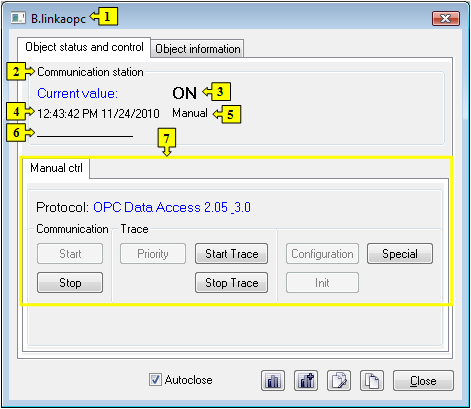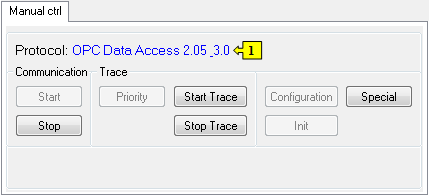Controlling communication stations
Clicking a graphic object with a communication station connected to control (the user has insufficient access rights) opens the following control window that consists of two tabs:
Object status and control
Object information
Object status and control
| 1 | Name of communication station. |
| 2 | Description of the communication station. |
| 3 | Current value of the communication station. |
| 4 | Time when the objects has got the current value. |
| 5 | States of the communication station. |
| 6 | Object value flags (user attributes). There are shown the flags, the value of which is TRUE. |
| 7 | Part of control window for controlling the communication station. |
| Opens a dynamic graph of the communication station. | |
| Opens a multigraph of the communication station. | |
| Inserts the object into the current page of the Browser if opened. If is not opened, clicking the button opens it and inserts the object into the first page of the Browser. | |
| Copies the object name to Clipboard. | |
The bottom of the tab contains the tabs allowing to control the communication station (the tab Manual ctrl).
MANUAL CTRL
The tab contains buttons to control the communication station.
| 1 | Communication protocol of the station. |
| Start | Activate the communication with a station in case that the communication is stopped. |
| Stop | Stop the communication with the station. |
| Priority | Short-time preferred communication with particular station. |
| Start Trace | Start communication trace. |
| Stop Trace | Stop communication trace. |
| Configuration | Load I/O Tag settings from particular station. |
| Init | Data initialization from a sub-station archive. |
| Special | Historical data recovery from a station archive. After clicking the
button, it opens the following window for setting the interval from
which the historical data from station will be read and mask for
specification of I/O tags (only for protocols OPC DA and OPC HDA). The same action can be started by tell command GETOLDVAL. |






Pridať komentár